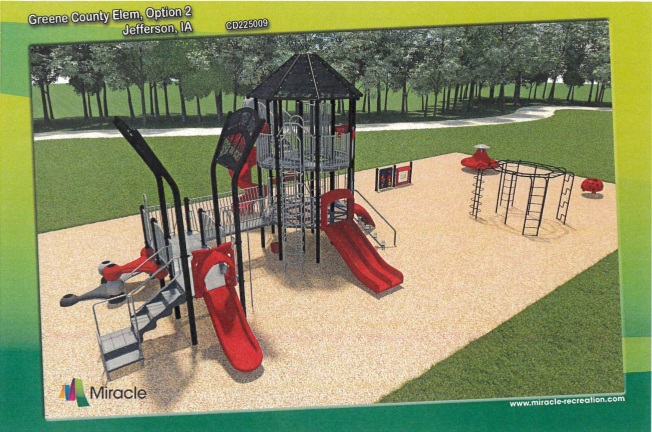Also okays new playground equipment
Greene County Schools board members spent close to an hour at a work session preceding their regular Sept. 18 meeting hearing administrators and high school teachers weigh in on a question of reducing the number of credits needed to graduate.
The discussion led to the appointment of a visioning committee charged with determining what students should know when they graduate and how they will demonstrate they know them.
The Iowa Department of Education requires 30 credits for graduation – eight credits of English/language arts; six each in math, science and social studies; two credits of physical education; and one credit each in health and financial literacy.
The Greene County schools require one credit of speech, for a total of 31 non-elective credits. However, students need 58 credits to graduate with a regular diploma.
Superintendent Tim Christensen and high school principal Brian Phillips are questioning the purpose of requiring that many elective credits.
According to Phillips, getting that many credits is a challenge for some students due to home or work issues. According to Christensen, decreasing the number of credits would give students more flexibility, it would decrease the drop-out rate, and it would be easier for students to access classes at the career academy.
About 10 teachers were part of the discussion. Many of them teach classes that are not on the required list, and they aren’t in favor of decreasing the number of credits to graduate. According to teachers, the elective classes provide diverse opportunities for students who don’t know yet what their interests are, and they provide students with variety during their day and school year.
The district now offers a basic diploma that requires only 42 credits for graduation. Students must go through an application process and justify to administrators and the board why they can’t meet the 58-credit requirement. Phillips and Christensen worry there’s a stigma associated.
Christensen suggested 42 credits as the requirement for all graduates.
At the regular meeting board members Steve Karber and Catherine Wilson volunteered to be on the visioning committee. Outgoing board president Mark Peters will be on the committee as a parent representative. The committee will also include curriculum director Karen Sandberg, members of the School Improvement Advisory Committee, and teacher leaders.
The board will discuss credit requirements again after the visioning committee meets.
Also at the regular meeting, the board held a public hearing and then approved the use of $63,740.39 from the district’s flexibility fund for new playground equipment at the elementary school. The funds were in the district’s professional development fund for the 2018-19 school year but were not used. Per a new state code approved by the 2017 legislature intended to give local control in the use of ending fund balances in certain funds, the funds can be transferred and then used for another purpose.
According to elementary principal Scott Johnson, the current playground equipment is rapidly deteriorating. The current tornado slide is original to the building in 1992,and the bridge piece was moved to Jefferson when the Scranton school was closed.
The new equipment will be installed by Boland Recreation of Marshalltown. Cost for the large piece of equipment and the four smaller pieces is $63,750.
The cost of new landscape fabric and rubber mulch, another $24,000, will come from the district’s physical plant and equipment levy (PPEL) fund.
Principal Johnson said the new equipment can accommodate 140 children at a time.
Board member and owner’s representative Sam Harding gave his monthly report on construction of the career academy and high school. According to Harding, the construction crew is now only one week behind schedule, after running two weeks behind most of the summer due to the very wet spring.
The footings for the auditorium are completed and the crew plans to begin setting the very tall precast concrete wall panels Sept. 30. Ninety percent of the career academy floor had been poured as of Wednesday, and Harding said work on the roof would being the week of Sept. 23.
The gymnasium floor, starting with the locker rooms, will be poured next.
Planning for the repurposing of the current high school to a middle school has begun. Only very preliminary planning had been done prior to the Sept. 10 special school election approving a Revenue Purpose Statement for the district’s share of the state 1-cent Secure A Vision for Education (SAVE) sales tax.
The board set the Oct. 16 meeting as the time for the public hearing required before transferring the Grand Junction school property to the city of Grand Junction. All demolition and site work at the former school location is complete.
